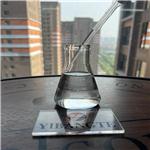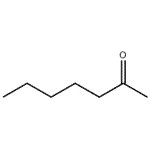2-Heptanone has a characteristic banana, slightly spicy odor. It may be prepared by oxidation of methyl n-amyl carbinol; also from n-amyl propionic acid or from ethyl butyl acetat.
2-Heptanone is a clear colorless liquid with a fruity, spicy, cinnamon, banana, slightly spicy odor. The ketone 2-heptanone is a polar molecular compound with dipole-dipole attractions between the molecules.
Colorless liquid with a banana-like odor. Can be detected at a concentration of 140 μg/kg (Buttery
et al., 1969a). Cometto-Mu?iz et al. (2000) reported nasal pungency threshold concentrations
ranging from approximately 195 to 935 ppm. An odor threshold concentration of 6.8 ppbv was
reported by Nagata and Takeuchi (1990).
Reported found in clove essential oil, Ceylon cinnamon and rancid coconut oil; also identifed in Ruta Montana Also reported found in banana, lingonberry, loganberry, black currant, guava, grapes, papaya, peach, pear, raspberry, other berries, strawberry jam, asparagus, roasted onion, leek, baked potato, mushroom, clove bud, ginger, blue, cheddar and Swiss cheeses, milk, cream, butter, fsh, meats, hop oil, beer, brandy, rum, malt whiskey, grape wines, cocoa, coffee, tea, peanuts, pecans, walnut, oats, soybeans, coconut oil, olive, passion fruit, mango, fgs, rice, sweet corn, corn tortillas, malt, caviar, shrimp, oysters, crab, crayfsh and mate
2-Heptanone is used as an industrial solvent; a solvent for
synthetic resin finishes; an inert reaction medium; a flavor
ingredient in foods; a fragrance ingredient in creams, lotions,
perfumes, soaps, and detergents.
Methyl amyl ketone is used as a flavoringagent and as a solvent in nitrocellulose lacquers, synthetic flavoring, perfumery and synthetic resins.
ChEBI: Heptan-2-one is a dialkyl ketone with methyl and pentyl as the alkyl groups. It has a role as a pheromone and a mouse metabolite. It is a dialkyl ketone and a methyl ketone.
By oxidation of methyl n-amyl carbinol; also from n-amyl propionic acid or from ethyl butyl acetate.
Detection: 1 ppb to 1.33 ppm; recognition: 2.66 to 3.73 ppm; aroma characteristics at 1.0%: cheesy ketonic, slightly green waxy, banana fruity.
Taste characteristics at 20 ppm: cheesy, fruity, coconut, waxy green, creamy, fungal with buttery and brown fruity nuances.
A clear colorless liquid. Flash point 126°F. Less dense than water and only slightly soluble in water. Hence floats on water. Vapors heavier than air. Density 6.8 lb / gal. Used as a synthetic flavoring and in perfumes.
Flammable. Slightly soluble in water.
2-Heptanone reacts exothermically with many acids and bases to produce flammable gases (e.g., H2). The heat may be sufficient to start a fire in the unreacted portion. Reacts with reducing agents such as hydrides, alkali metals, and nitrides to produce flammable gas and heat. Incompatible with isocyanates, aldehydes, cyanides, peroxides, and anhydrides. Incompatible with many oxidizing agents including nitric acid, nitric acid/hydrogen peroxide mixture, and perchloric acid. May form peroxides [USCG, 1999].
Moderate fire risk. Toxic by inhalation, skin
and eye irritant, narcotic in high concentration.
Exposure to methyl amyl ketone causedirritation of mucous membranes, mild tomoderate congestion of the lungs, and narcosis in test animals. A 4-hour exposure to a4000-ppm concentration in air was lethal torats; 1500–2000 ppm produced lung irrita�tion and narcosis. The concentration at whichit produces similar symptoms in humans isnot known.
The oral toxicity of this compound is low.Its irritant action on skin should be low tovery low.
LD50 value, oral (mice): 730 mg/kg.
Combustible liquid, flash point (closed cup)
39.9°C (102°F), (open cup) 48.9°C (12°F);
vapor density 3.9 (air = 1) vapor pressure
2.6 torr at 20°C (68°F); autoignition tempera�ture 393°C (740°F); fire-extinguishing agent:
“alcohol” foam; a water spray may be used
to cool below its flash point.
Methyl amyl ketone forms an explosive
mixture with air in the range 1.1% [at 66°C
(150.8°F)] to 7.9% [at 121°C (249.8°F)] by
volume. It can react explosively with strong
acids, alkalies, and oxidizing agents.
Moderately toxic by
ingestion. Mildly toxic by inhalation and skin
contact. A skin irritant. A flammable liquid
when exposed to heat or flame; can react
with oxidizing materials. To fight fire, use
foam, CO2, dry chemical. When heated to
decomposition it emits acrid smoke and
fumes. See also KETONES.
Primary Irritant. Methyl amyl ketone is used as a solvent in metal roll coatings and in synthetic resin finishes; as a solvent for nitrocellulose in lacquers and as a relatively inert reaction medium.
If this chemical gets into the eyes, remove any contact lenses at once and irrigate immediately for at least 15 min, occasionally lifting upper and lower lids. Seek medical attention immediately. If this chemical contacts the skin, remove contaminated clothing and wash immediately with soap and water. Seek medical attention immediately. If this chemical has been inhaled, remove from exposure, begin rescue breathing (using universal precautions, including resuscitation mask) if breathing has stopped and CPR if heart action has stopped. Transfer promptly to a medical facility. When this chemical has been swallowed, get medical attention. Give large quantities of water and induce vomiting. Do not make an unconscious person vomit.
Identified as one of 140 volatile constituents in used soybean oils collected from a
processing plant that fried various beef, chicken, and veal products (Takeoka et al., 1996). Also identified as a volatile constituent released by fresh coffee beans (Coffea canephora variety
Robusta and Coffea arabica) at different stages of ripeness (Mathieu et al., 1998).
Biological. Heukelekian and Rand (1955) reported a 10-d BOD value of 0.50 g/g which is
17.8% of the ThOD value of 2.81 g/g.
Chemical/Physical. Atkinson et al. (2000) studied the kinetic and products of the gas-phase
reaction of 2-heptanone with OH radicals in purified air at 25 °C and 740 mmHg. A relative rate
constant of 1.17 x 10-11 cm3/molecule·sec was calculated for this reaction. Reaction products
identified by GC, FTIR, and atmospheric pressure ionization tandem mass spectroscopy were
(with respective molar yields): formaldehyde, 0.38; acetaldehyde, λ0.05; propanal, λ0.05; butanal,
0.07; pentanal, 0.09; and molecular weight 175 organic nitrates.
2-Heptanone will not hydrolyze because it does not contain a hydrolyzable functional group.
Burns in air releasing carbon monoxide and carbon dioxide.
Color Code—Red: Flammability Hazard: Store in a flammable liquid storage area or approved cabinet away from ignition sources and corrosive and reactive materials. Prior to working with this chemical you should be trained on its proper handling and storage. Before entering confined space where this chemical may be present, check to make sure that an explosive concentration does not exist. Methyl (n-amyl) ketone must be stored to avoid contact with oxidizers, such as perchlorates, peroxides, chlorates, nitrites, and permanganates, since violent reaction occur. Store in tightly closed containers in a cool, well-ventilated area away from heat or flame. Sources of ignition, such as smoking and open flames, are prohibited where methyl (n-amyl) ketone is used, handled, or stored in a manner that could create a potential fire or explosion hazard.
UN1110 n-Amyl Methyl ketone, Hazard Class: 3;
Labels: 3-Flammable liquid.
2-Heptanone is metabolized in the liver and causes toxicity by
oxidative and free radical mechanisms. It is known to potentiate
both nephrotoxic and hepatotoxic effects of halogenated
hydrocarbons.
Forms explosive mixture with air. Strong acids, alkalis, oxidizers. Attacks some forms of plastics.
Dissolve or mix the material
with a combustible solvent and burn in a chemical incinerator
equipped with an afterburner and scrubber. All federal, state,
and local environmental regulations must be observed.



